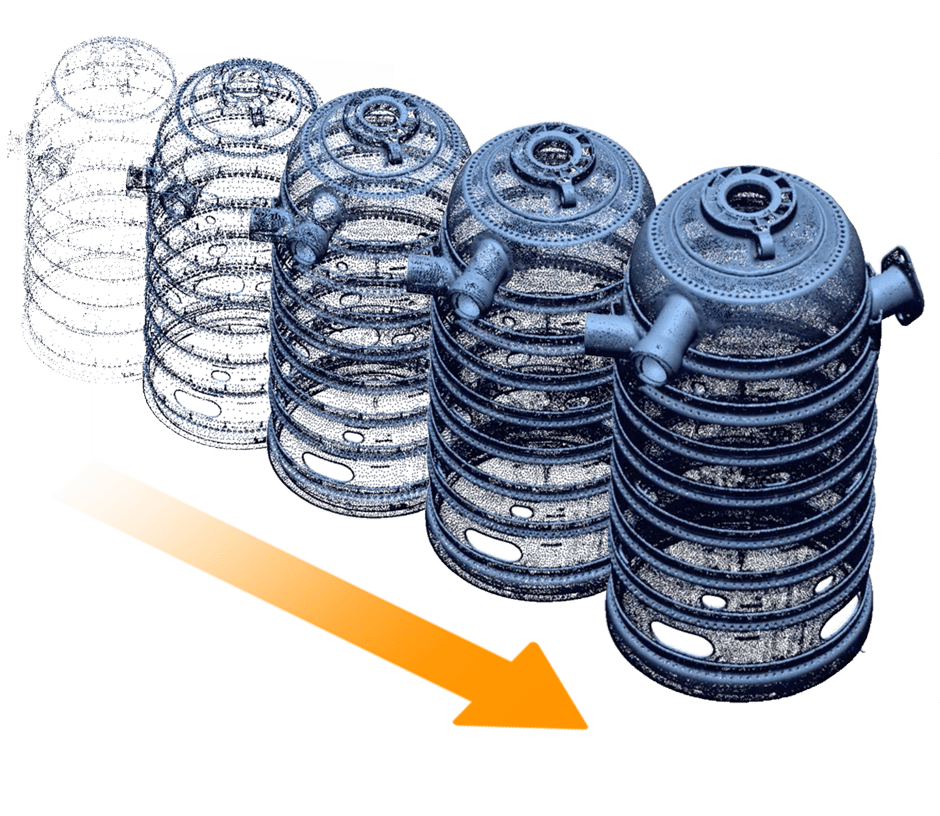
A resolução faz a diferença
A digitalização 3D abre um mundo de possibilidades. Imagine poder capturar qualquer objeto no mundo físico e ter um modelo digital em minutos.
Você não precisa imaginar. Todos os dias, as empresas usam scanners 3D e software para:
- Criar e fazer engenharia reversa de modelos CAD de peças reais para capturar designs perdidos, atualizar produtos existentes e criar novos.
- Verificar a qualidade do produto comparando peças fabricadas com designs CAD.
- Fazer produtos personalizados em massa para saúde, odontologia e moda.
- Digitalizar edifícios inteiros para criar modelos 3D precisos.
- E muito mais.
Os scanners 3D e o software que o acompanha estão agora ao alcance de muitos. Os scanners são mais rápidos, menos caros e mais precisos. O software de processamento de digitalização 3D é mais automatizado, cria melhores resultados e funciona mais rápido do que nunca.
O que são scanners 3D?
Existem muitos dispositivos diferentes que são chamados de scanners 3D. Qualquer dispositivo que mede o mundo físico usando lasers, luzes ou raios-X e gera nuvens de pontos densos ou malhas de polígonos pode ser considerado um scanner 3D. Eles têm muitos nomes,incluindo digitalizadores 3D, scanners a laser, scanners de luz branca, CT industrial, LIDAR e outros. O fator em comum de todos esses dispositivos é que eles capturam a geometria de objetos físicos com centenas de milhares ou milhões de medições.
Por que você precisa do software de digitalização 3D?
Como os scanners coletam imensas quantidades de dados, você precisa de software dedicado de engenharia reversa, como Geomagic® Design X™, Geomagic para SOLIDWORKS® e Geomagic Wrap® para processar a saída em algo utilizável com o qual outros programas de software possam lidar. Dependendo da finalidade os dados de digitalização, o software de engenharia reversa pode fazer muitas coisas diferentes com eles. As aplicações mais comuns para digitalização 3D são engenharia reversa, inspeção, arquivamento digital e impressão 3D. Software dedicado, como o software de engenharia reversa Geomagic e o software de inspeção e metrologia Geomagic Control X™, é a maneira mais rápida e fácil de liberar todo o potencial de um scanner 3D.
Como funcionam os scanners 3D?
Existem muitas abordagens diferentes para a digitalização 3D, com base em diferentes princípios de imagem. Algumas tecnologias são ideais para digitalização de curto alcance, enquanto outras são melhores para digitalização de médio ou longo alcance.
Scanners 3D de curto alcance
Os scanners 3D com menos de um metro de distância focal incluem triangulação a laser e scanners de luz 3D estruturada.
Scanners de triangulação a laser 3D
Os scanners de triangulação a laser usam uma linha de laser ou um único ponto de laser para digitalizar um objeto. Um sensor capta a luz de laser que é refletida fora do objeto e, usando triangulação trigonométrica, o sistema calcula a distância entre o objeto e o scanner.
A distância entre a fonte de laser e o sensor é determinada com muita precisão, bem como o ângulo entre o laser e o sensor. À medida que a luz de laser reflete sobre o objeto digitalizado, o sistema pode discernir em que ângulo ele está retornando ao sensor e, portanto, a distância da fonte de laser até a superfície do objeto.
Scanners 3D de luz estruturada (luz branca ou azul)
Os scanners de luz estruturada também usam triangulação trigonométrica, mas em vez de olhar para a luz de laser, esses sistemas projetam uma série de padrões lineares em um objeto. Em seguida, examinando as bordas de cada linha no padrão, eles calculam a distância entre o scanner e a superfície do objeto. Essencialmente, em vez de a câmera ver uma linha de laser, ela vê a borda do padrão projetado e calcula a distância de forma semelhante.
|
Scanners 3D de curto alcance |
Vantagens |
Desvantagens |
|
Triangulação a laser |
|
|
|
Luz estruturada |
|
|
Scanners 3D de médio a longo alcance
Os scanners 3D com um ou mais metros de distância focal incluem scanners 3D de deslocamento de fase de laser e baseados em pulsos de laser.
Scanners 3D baseados em pulsos de laser
Os scanners baseados em pulsos de laser, também conhecidos como scanners de tempo de voo, são baseados em um conceito muito simples: a velocidade da luz é conhecida por sua extrema precisão, então se soubermos quanto tempo um laser leva para alcançar um objeto e refletir de volta para um sensor, saberemos a que distância esse objeto está. Esses sistemas usam circuitos com precisão de picossegundos para medir o tempo que leva para milhões de pulsos de laser retornarem ao sensor e calcular uma distância. Ao girar o laser e o sensor (geralmente através de um espelho), o scanner pode digitalizar até 360 graus em torno de si mesmo.
Scanners 3D Laser Phase-Shift
Os scanners de deslocamento de fase de laser são outro tipo de tecnologia de scanner 3D de tempo de voo e funcionam conceitualmente de forma semelhante aos sistemas baseados em pulsos. Além de pulsar o laser, esses scanners também modulam a potência do feixe de laser, e o scanner compara a fase do laser que está sendo enviado e que depois retornou ao sensor. A medição do deslocamento de fase é mais precisa.
|
Scanners 3D de médio a longo alcance |
Vantagens |
Desvantagens |
|
Laser Pulse-Based |
De médio e longo alcance (2 m—1.000 m) |
|
|
Laser Phase-Shift |
|
Somente médio alcance |